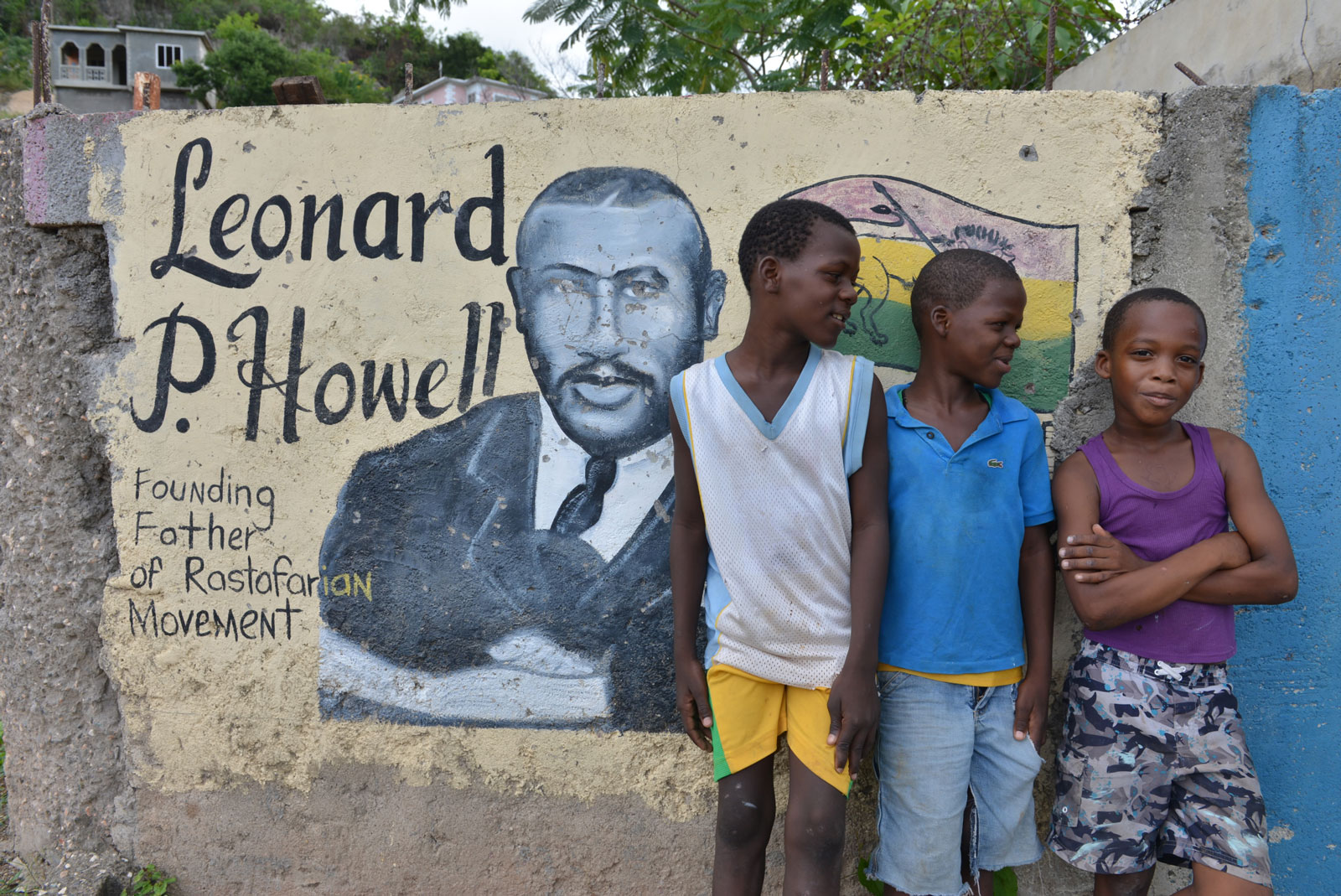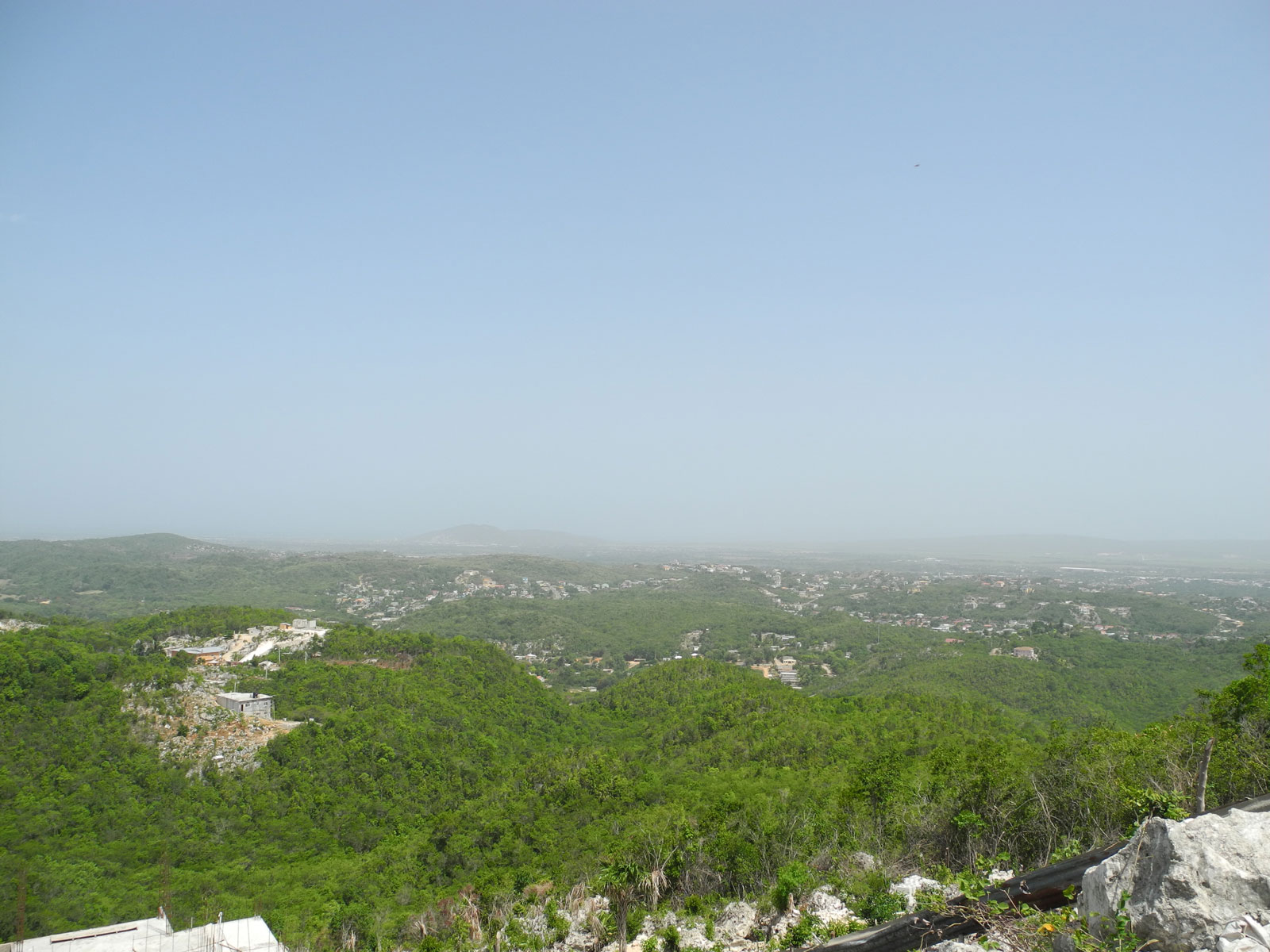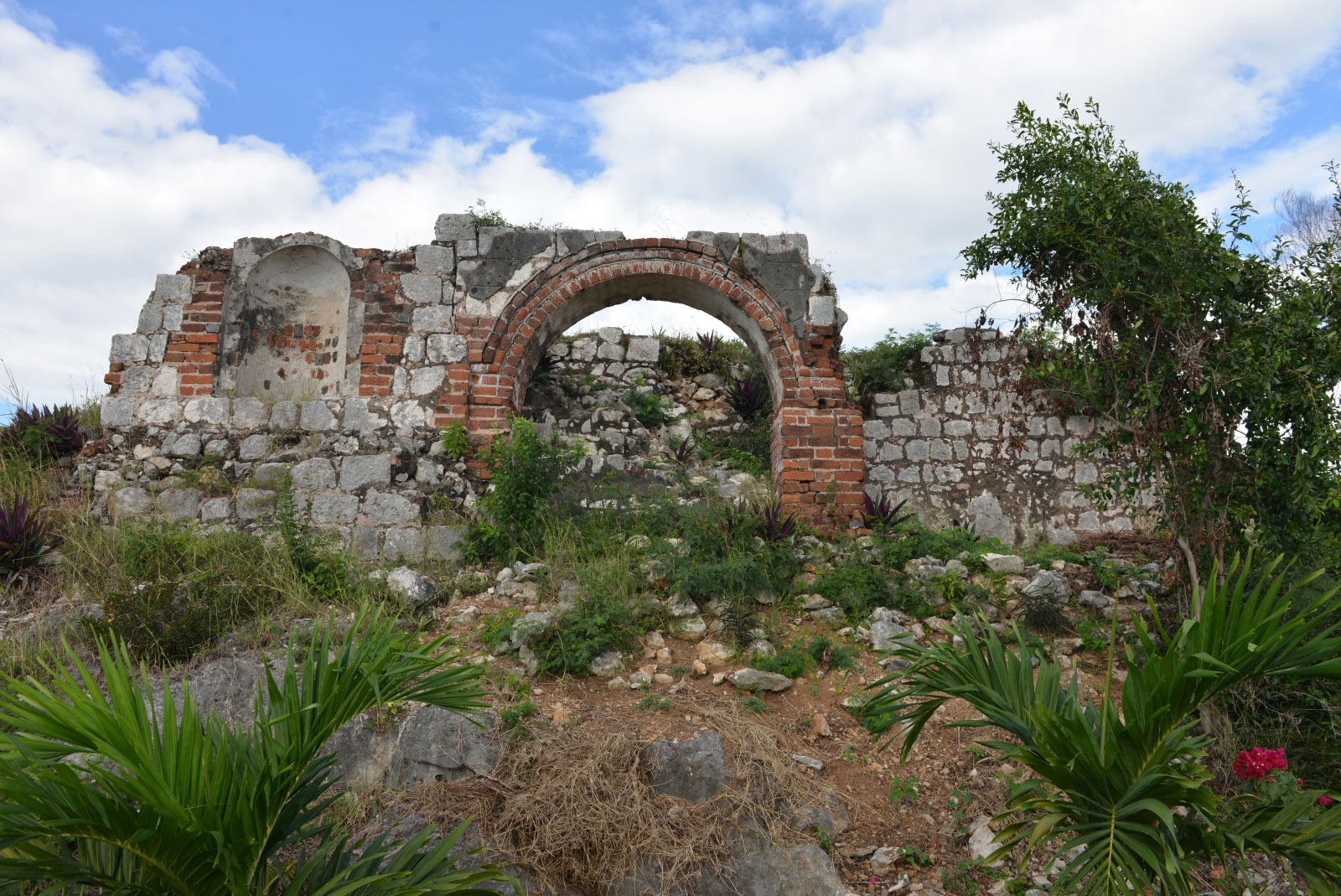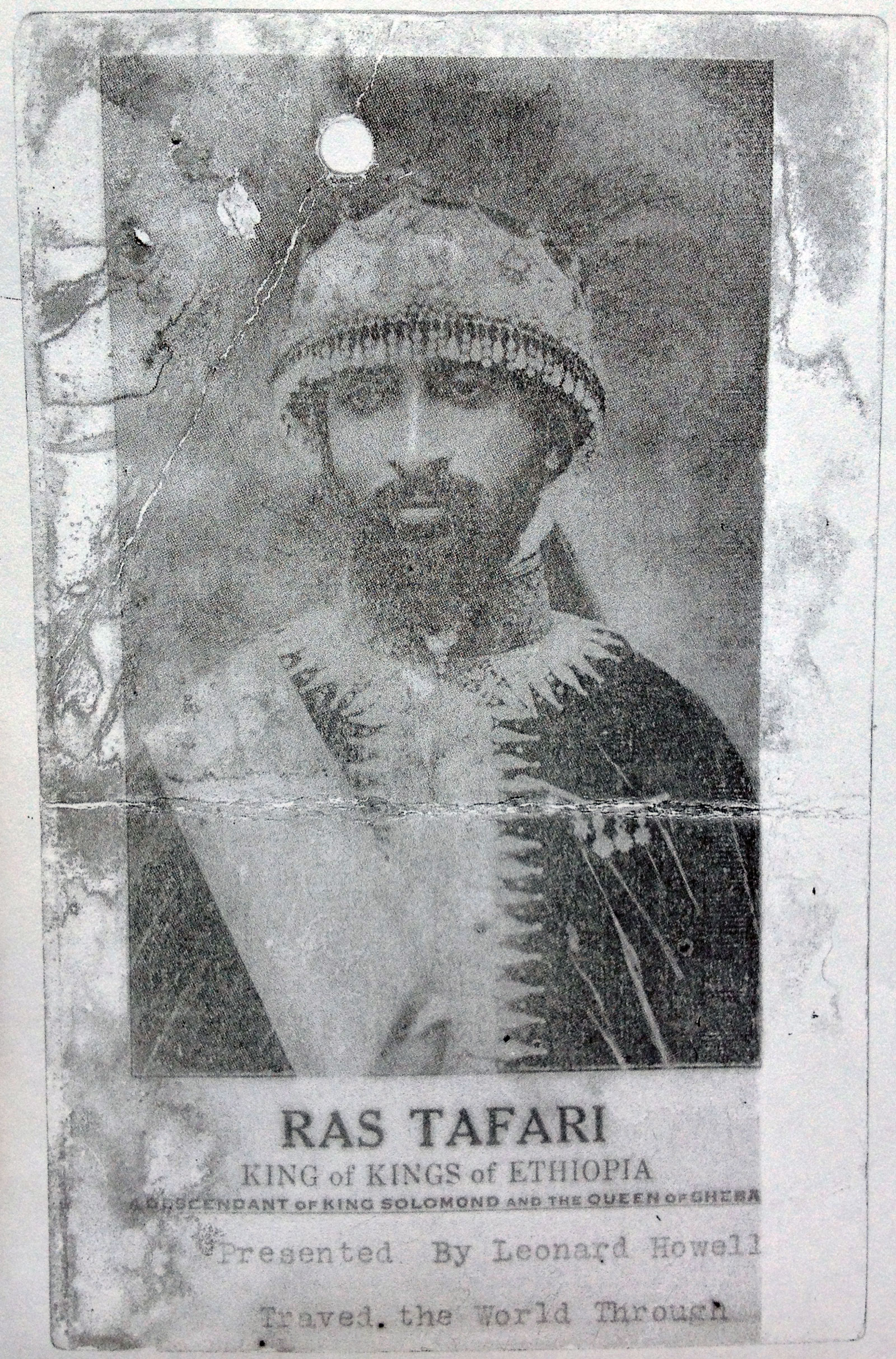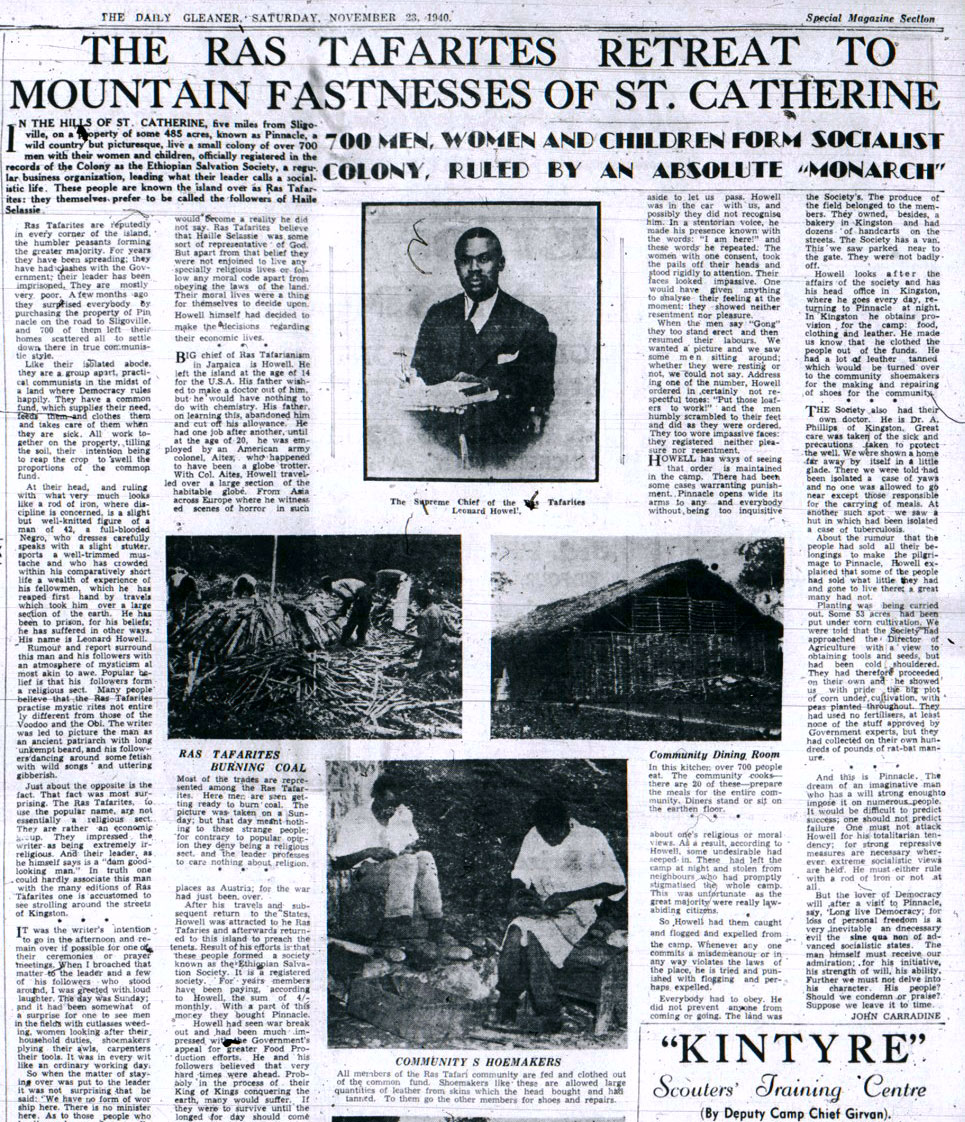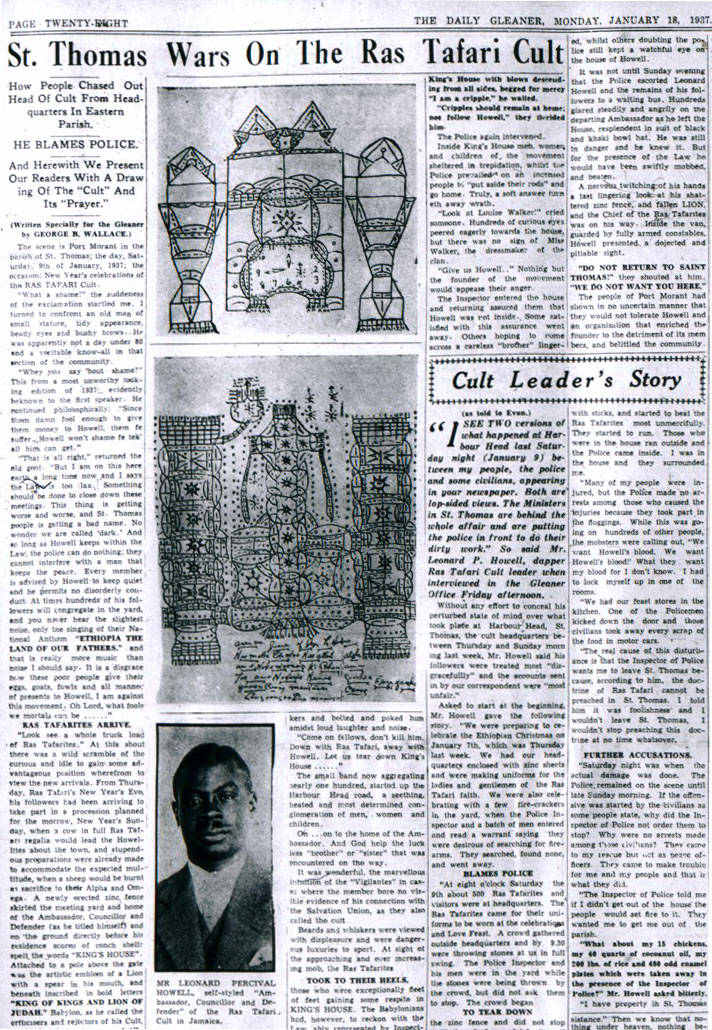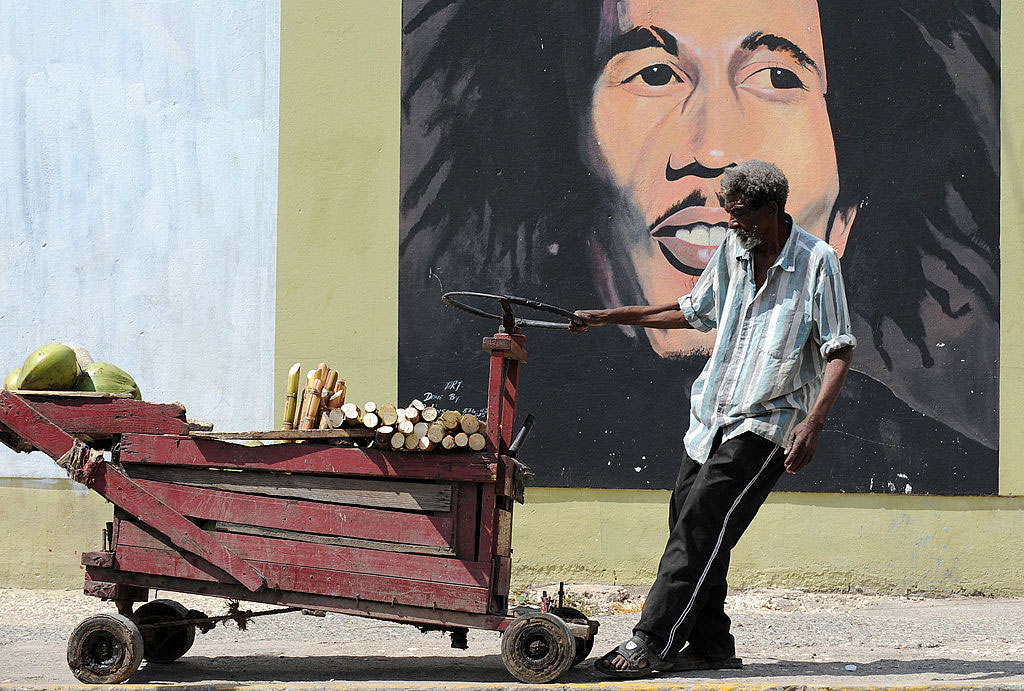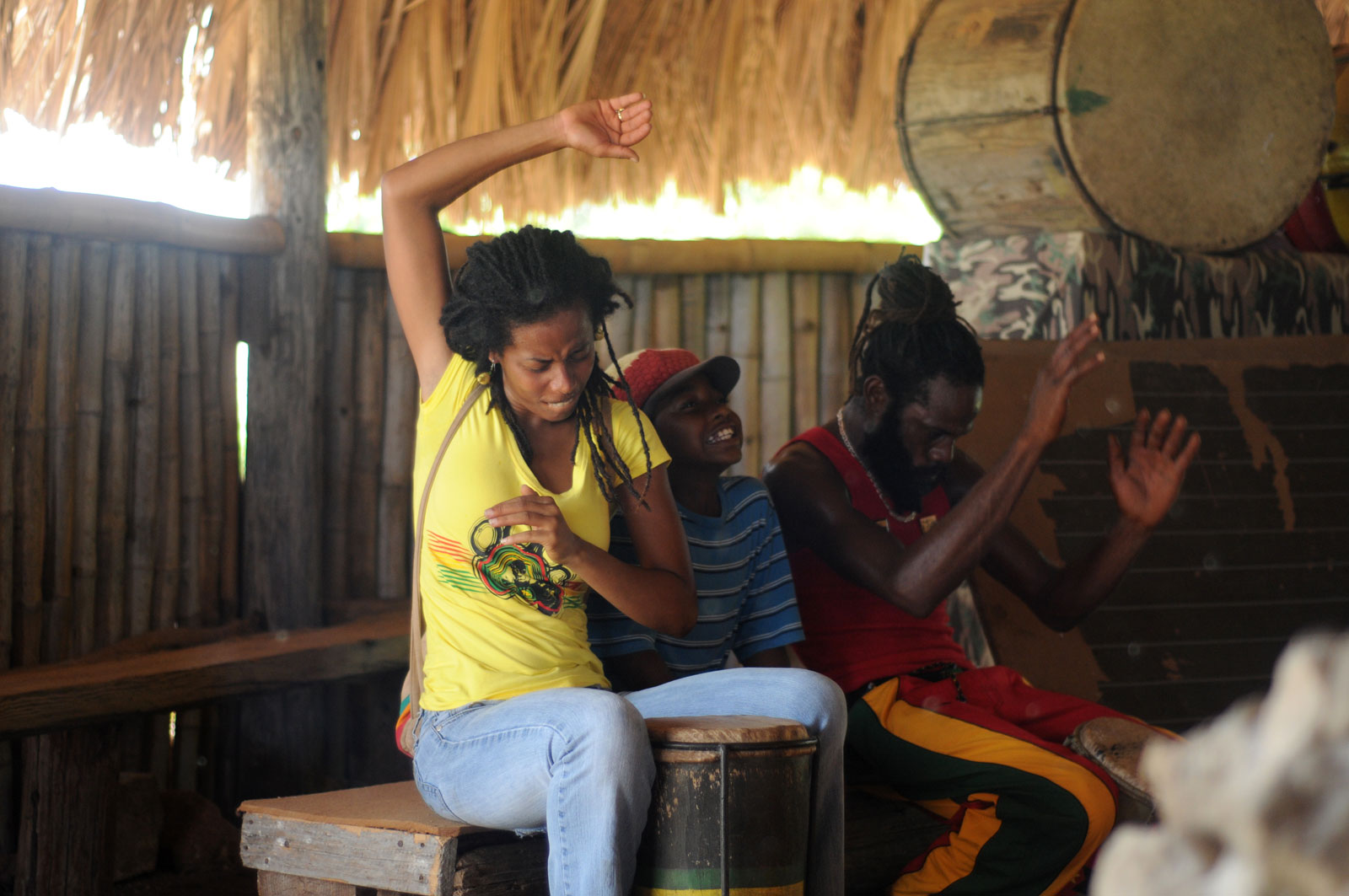In the postcard view of Jamaica, Bob Marley casts a long shadow. Though he’s been dead for thirty-five years, the legendary reggae musician is easily the most recognizable Jamaican in the world—the primary figure in a global brand often associated with protest music, laid-back, “One Love” positivity, and a pot-smoking counterculture. And since Marley was an adherent of Rastafari, the social and spiritual movement that began in this Caribbean island nation in the 1930s, his music—and reggae more generally—have in many ways come to be synonymous with Rastafari in the popular imagination.
For Jamaica’s leaders, Rastafari has been an important aspect of the country’s global brand. Struggling with sky-high unemployment, vast inequality, and extreme poverty (crippling debt burdens from IMF agreements haven’t helped the situation), they have relied on Brand Jamaica—the government’s explicit marketing push, beginning in the 1960s—to attract tourist dollars and foreign investment to the island. The government-backed tourist industry has long encouraged visitors to Come to Jamaica and feel all right; and in 2015, the country decriminalized marijuana—creating a further draw for foreigners seeking an authentic Jamaican experience. The Jamaica Intellectual Property Office (JIPO), which is located in the same building as the government’s larger Jamaican Promotions Agency (JAMPRO) in Kingston, works to protect the country’s name and trademarks from registration by outside entities with no connection to Jamaican goods and services. Meanwhile, Brand Jamaica is being exploited globally too, with billions of dollars of revenue generated each year from Rasta-themed products—from clothing and headphones to pipes, even energy drinks.
Yet it can be hard to reconcile the image sold to the world with local realities—not to mention the original politics and principles of the Rastafari movement. Rastafari began not simply as a form of countercultural expression or fringe religious belief. It involved a fight for justice by disenfranchised Jamaicans, peasant laborers and the urban underemployed alike, in what was then a British colony. In the 1930s, the Rastafari established a self-sufficient community to put their beliefs into practice. Almost eighty years later, the people Marley’s music spoke to—members of Jamaica’s “sufferah” underclass—continue to live in deep poverty, while the redemptive social organization the movement sought to create has been largely forgotten.
Nowhere has this irony been more evident than on the issue of marijuana itself. For decades, Rastafari were persecuted by the Jamaican government for their use of cannabis in rituals, and their efforts to cultivate it; now for the first time Rastafari can legally grow and use cannabis for sacramental purposes (to grow it commercially requires a license from the state that involves considerable expense—typically beyond the means of the movement’s rank-and-file). The country now has an opportunity to profit from the marijuana industry. Meanwhile, descendants of the original Rasta community are in danger of losing what remains of the land in central Jamaica where their movement began.
The original Rastafari settlement, known as Pinnacle, occupied a large expanse of mountainous land from Sligoville Road to the Rio Cobre river, with spectacular 360-degree views. Today, looking out across lush green and deep brown canopies that lead all the way down to Spanish Town, one can see Kingston, the Jamaican capital, further still. Newer houses sit along the winding roads up to Pinnacle’s highest point—and increasingly, large garish properties and hotels under construction. At the very top, the ruins of a Great House and bakery once used by the original community still stand in crumbling stone, a red, green, and gold flag punctuating blue skies. Just below, a newer structure, circular and made of cane wood, called a tabernacle or sanctuary, is where contemporary adherents to Rastafari still occasionally gather for celebrations.
Pinnacle’s story began in the 1930s, in British-ruled Jamaica, when a street preacher named Leonard Percival Howell (1898-1981) gained a large following among the lower classes. Inspired by revivalist and Ethiopianist movements that took hold in Jamaica from the late eighteenth century, and drawing on an Africanism distinct from European Christianity, Howell sought to create a spiritual practice that would also offer a political voice to the island’s downtrodden workers. Howell’s Pinnacle, originally intended as a temporary community for those hoping to repatriate to Ethiopia, soon became home to hundreds, at times thousands, of Jamaicans. It was a place where members of the underclass could go in the absence of institutional support that plagued the large number of Jamaicans descended from the formerly enslaved, who had few rights and continued to face systemic discrimination.
Advertisement
After slavery was abolished in the British Empire in 1834, “free villages”—settlements founded by various non-conformist denominations independent of the control of the landowning and planter class—offered some assistance to the formerly enslaved. But throughout the following century, many black Jamaicans continued to live in abject poverty and were forced to depend on wealthy, lighter-skinned landowners for their livelihood. Control of one’s land was the real marker of freedom, and in the 1930s—struggling against unyielding colonial taxation and landowners who were unwilling to sell them land, and amid a worldwide depression—few had attained that dream.
In 1938, a century after emancipation, these ruthless conditions led to island-wide labor uprisings that further catalyzed the drive for independence from the island’s British overlords. Around this time, the emerging labor movement also led to the founding of the two main political parties, the People’s National Party (PNP) and the Jamaican Labor Party (JLP). In 1939 Howell managed to buy or lease land—estimates range from a few hundred to a couple thousand acres, and the details remain hazy—from Albert Chang, a prominent member of Jamaica’s Chinese community and the owner of a grocery franchise. It’s not clear whether Chang supported Howell’s cause. Hélène Lee, in her chronicle of Howell’s life, The First Rasta, reports that Howell paid Chang £1200, partly with profits from selling land he inherited after his father’s death.
“The Rastafarians are not essentially a religious sect,” wrote John Carradine, a reporter for one of Jamaica’s main newspapers, The Daily Gleaner, in 1940. “They are rather an economic community.” Fashioned in the style of an African village, Pinnacle promoted what Howell reportedly called “a socialistic life” based on principles of communalism and economic independence from the colonial system.
Two of Howell’s sons, Monty and Bill (nicknamed “Blade”), in their seventies today, grew up at Pinnacle. They remember it as a peaceful society with acres of land to explore. “It was paradise,” Bill says. “My mind is still there.” Families worked together to cultivate a range of crops, burn hardwood for charcoal, operate a bakery, make crafts, and raise livestock—all for their own subsistence or to sell in the Spanish Town Market. In particular, the cultivation and sale of ganja, or marijuana, quickly enabled the community to become economically independent. Pinnacle observed traditional family structures, though Lee writes in The First Rasta that Howell’s relationships with a number of women were difficult for his wife Tyneth.1
Even before Pinnacle was established, Howell and other street preachers had been moving away from Christianity toward a radical new focus. After the 1930 crowning of Ethiopia’s Emperor Haile Selassie I, born Tafari Makonnen, itinerant preachers in Kingston and the adjacent parishes celebrated the divinity of Ras (Prince) Tafari, who, at his coronation as emperor, took on titles—King of Kings, Lord of Lords—that were reserved in the Bible for the second coming of Christ. Ras Tafari, Howell declared, was the rightful ruler of all black Jamaicans rather than British monarch George V. In the eyes of his Jamaican followers, Emperor Selassie’s resistance to Mussolini’s invasion of his kingdom in 1935 underscored his divine status. After acquiring the property, Howell officially registered Pinnacle as The Ethiopian Salvation Society.
Howell was born in Clarendon, a rural parish in south-central Jamaica. All places beyond Kingston are referred to as “country,” but much of Clarendon truly fits the description—with brush and bush and fields of grassy sugar cane stretching to the horizon. Unlike those around him, Howell’s father was a prosperous farmer, who owned his own land and was later appointed a lay preacher. As a teenager Howell left the island for Colón, Panama, where many Caribbean people were migrating as laborers to dig the canal. He traveled as a seaman between Panama and New York City, and even to Europe, finally opening a tea room in Harlem in 1924. This was his base as he continued to travel until 1932, when it seems he was deported back to Jamaica (the reason for his indictment is unclear, though Lee hypothesizes that he may have served cannabis drinks in his “tea room”).
These experiences exposed Howell to Pan-Africanism, as well as Marxism, Communism, and various strands of Black Nationalism. During his time in New York, he joined fellow Jamaican Marcus Garvey’s Universal Negro Improvement Association (UNIA), founded in 1914. But while he was clearly influenced by Garvey’s thinking—so much so that Garvey is often mistakenly identified as the founder of Rastafari—Howell had a mixed relationship with Garvey, a Christian, who later criticized the nascent Rastafari movement as a “cult.” (In December, US Congress members urged President Obama to posthumously pardon Garvey, who is considered a national hero in Jamaica, and whose 1923 conviction in New York many believe was politically and racially motivated.)
Advertisement
When Howell returned to Jamaica in 1932—two years after Haile Selassie I was crowned emperor of Ethiopia—he began holding public meetings, fusing all that he’d learned abroad with local ideas. His worldliness and gifts as a speaker not only attracted Jamaica’s underclass, they gained him the attention of local authorities. Already in 1933, the colonial police force had identified the “type of persons attending” Howell’s meetings as “the poor and ignorant who apparently have nothing else to do.” Howell was put under police surveillance, arrested numerous times on charges of sedition, and sentenced to years of hard labor. He was called a “cult leader” and “absolute monarch” in the newspapers. “The most dangerous man on the island,” Bill says of his father at the time. “This man come and say an Ethiopian man God? After we know Christ was a white, long-haired, blonde person? Are you crazy?” In fact, Howell was also committed more than once to Jamaica’s Bellevue Psychiatric Hospital, another attempt to defuse his perceived threat to the state.
But for the authorities, the greatest menace to the colonial order was Howell’s founding of Pinnacle as an autonomous economic community financed by the cultivation of marijuana. “Ganja” (an Indo-Aryan word) had originally reached Jamaica in the mid-nineteenth century by way of East Indian indentured laborers, who used the herb in their spiritual ceremonies and were brought to Jamaica to fill the labor demand created by emancipation. Howell’s Rastafari spirituality amalgamated East Indian and African customs and beliefs—an approach that incorporated ceremonial ganja-smoking with the drumming, singing, and chanting of Kumina, an Afro-Jamaican religion developed by central Africans brought to the island enslaved or, like the East Indians, indentured. By the late 1940s and early 1950s, at Pinnacle’s height, Howell was the biggest ganja planter in modern Jamaican history.
This left Pinnacle in a precarious legal position. Ganja had been illegal in Britain and its colonies since 1924, and the community’s efforts to harvest it became a pretext for continual police raids on and shakedowns of the settlement. Monty and Bill Howell recall that colonial police repeatedly confiscated valuables and destroyed documents, claiming they were seditious. Monty says his father pulled people away from the nearby sugar estate where Alexander Bustamante, founder of the JLP party, was then a union leader. “Bustamante didn’t like that,” Monty says. In a 1939 letter, Bustamante warned the Colonial Secretary that Howell was “a danger to the peace of the Community…the greatest danger that exists in this country today,” and recommended that the local inspector of police investigate him. Bustamante would go on to be Jamaica’s first prime minister following British rule.
During these years, the Jamaican independence movement was gaining strength, and Pinnacle was viewed as a dangerous manifestation of the new anti-colonial resistance movement, and also potentially as a threat to the island’s emerging political parties. Starting in 1944, however, Pinnacle somehow managed to flourish for a decade in prosperity and relative peace, largely left alone by the authorities—Lee hypothesizes that political bigwigs like Bustamante may have cut some kind of deal with Howell.
Then came the spring of 1954. That year, Pinnacle had produced an exceptionally large ganja crop. On the morning of May 22, more than a hundred colonial police officers, supervisors, and detectives converged on the community, arresting over a hundred people and sentencing a majority of them to prison terms of up to two years, destroying acres of ganja plants, confiscating thousands of pounds in cash, and burning more than three tons of ganja. International efforts to control the cultivation and trade of ganja may have accelerated at the time—Lee writes that many believe Winston Churchill was personally pressuring Jamaican officials to shut down the ganja trade. It was the biggest ganja bust in Jamaican history and it was the final blow to Pinnacle’s prosperity.
Around the time of the 1954 raid, a widespread rural-to-urban migration was occurring throughout Jamaica, and the center of the Rastafari movement shifted to the capital. It was during these years that a young Bob Marley moved with his mother from Nine Mile village in St. Ann parish to the crowded government yards of Trench Town, Kingston. The decade of the Fifties was a time of musical experimentation in Jamaica, in part because the island’s musical traditions were being transplanted from rural parishes and mixed with popular styles in West Kingston’s shanty towns. From this amalgam came ska, with its offbeat rhythm guitar and horns—then the slower groove of rocksteady. Amid these developments, a new sound began emerging among artists like Jimmy Cliff, Big Youth, Burning Spear—and soon after, Marley, Peter Tosh, and Bunny Wailer—and a dance came to name the genre with Toots and The Maytals’s 1968 Do The Reggay. Reggae itself was inspired in part by the ferment surrounding the country’s independence from Britain in 1962, a time of upheaval and hope. And reggae, like Howell, offered Jamaicans a popular language for understanding and reacting to their country’s particular history and how it connected to other liberation movements.
Renowned Rasta elder Mortimer Planno saw promise in the power of music and entertainment to spread the movement, and it’s widely held that he charged Marley with the task of bringing Rastafari to the world through reggae. In writing the movement’s founding text, Howell gave himself the epithet Ganguru Maragh—a hybrid of Hindi words often shortened to Gong (a combination of “gyan” or wisdom, “gun” or virtue, “guru” or teacher, and “maragh” or great king, writes Robert A. Hill in Dread History). It seems plausible that Marley’s record label, Tuff Gong Records, referred back to Howell’s quasi-Hindi pen name—adding for good measure some tough-guy badness, a valuable currency in Jamaica. Marley’s music soon resounded like a gong throughout the world.
But as reggae flourished, the fortunes of Pinnacle and its original followers declined. After the devastating 1954 raid, and another in 1958, both of which amounted to violent evictions, those who remained regrouped at nearby Tredegar Park and Cross Pen. Meanwhile, as Rastafari spread throughout the island, morphing into various factions, called “mansions,” authorities continued to repress the now multifarious movement, often brutally.
The west Kingston community, Back O’Wall, which Marley likely visited, was one center of Rasta thought in the Fifties and early Sixties. Labeled a violent slum by politicians, it was bulldozed in the mid-1960s, replaced by low-income housing, and renamed Tivoli Gardens by the JLP, then in power—an example of the type of “garrison” housing projects run by criminal leaders or “dons,” allied to one of the warring political parties that had developed around the time of Pinnacle’s origins.
By the 1970s, reggae was identified as a globally profitable export, and many producers got rich while their artists had to fight for pay. Politicians became increasingly aware of the attention Marley was getting overseas and began to recognize that Rastafari culture, with its connection to the music, was integral to Brand Jamaica. By then Jamaica was known to be one of the US’s primary sources of marijuana, and some Jamaican politicians and businessmen were becoming wealthy from the drug trade, though it remained illegal.
Just as the culture and lyrics of dancehall are used by politicians today to appeal to young voters, reggae lyrics and Rasta expressions were evoked in Jamaican politics beginning in the 1970s, along with other symbols of Rastafari—like former Prime Minister Michael Manley’s famous “rod of correction,” a carved stick given to him by Haile Selassie—demonstrating the major influence of Rastafari on the independent nation’s emerging national identity.
More than forty years later, however, Howell and the original Rastafari community have been thrust back into the national debate, as the decriminalization of marijuana has occurred while controversy surrounds efforts to redevelop the land at Pinnacle. In January 2014, a Jamaican court ruled that part of the land legally belonged to St Jago Hills Development Company Limited. As a result, more than one hundred people living in and around Pinnacle, some of them members and descendants of the original community, were evicted. Today, one lot—a quarter of an acre—has been preserved by the Jamaica National Heritage Trust, and protected from development, while the owner of St Jago Hills, Richard Lake2, has begun developing properties on parts of the rest.
Following the court decision, Donisha Prendergast, Bob Marley’s eldest granddaughter, an artist and activist, organized Occupy Pinnacle, a movement to reclaim the property. She partnered with The Leonard Howell Foundation and Howell’s sons, Monty and Bill, to appeal the court’s decision, but their appeal was denied.
Occupy Pinnacle and Howell’s sons claim that the land was illegally taken from Howell, and that the acquisition of Pinnacle by Lake’s family in 1989 should not be upheld. They also fear that land boasting such spectacular views will be developed into spaces available only to the wealthy, destroying not only a historically important site, but doing so in direct ideological opposition to all that Howell stood for. Rastafari people are recognized under the 2007 United Nations Declaration on the Rights of Indigenous Peoples (UNDRIP), and Rasta people have fought, along with other indigenous Jamaican communities, for historical sites like Pinnacle to be protected.
But though the former government agreed in 2014 to protect approximately 1.25 acres from development, to add to the quarter acre already preserved, it’s been slow to act. Since the election of a new government last year, led by Prime Minister Andrew Holness, Jamaican officials have made encouraging public statements, but nothing has happened. Occupy Pinnacle and Howell’s sons envision a civic education center or museum open to the public, as well as a monument for Howell and—perhaps most important—protection of the many burial sites throughout the property, including that of their mother Tyneth.
“If you take everything Rasta out of Brand Jamaica there’s no brand,” Prendergast says. She would also like to develop infrastructure for cooperative industries benefiting Rasta communities at Pinnacle, potentially including ganja research and cultivation. “We want to create the infrastructure for the community to empower itself.”
But even as marijuana tourism increases, and a medical marijuana industry begins to develop in Jamaica, it seems unlikely that the profits of decriminalization will benefit everyday Rasta people—not to mention the original descendants of Pinnacle. In addition, some feel that law enforcement hasn’t caught up with the law. In early November a group protested in St. James after more than ten pounds of marijuana belonging to a Rasta was allegedly seized by police.
During Howell’s earthstrong celebration a couple of years ago—June 16, 2014, what would have been his 116th birthday, five months after Pinnacle’s most recent eviction—a group of about thirty Rastafari men passed a chalice pipe in the sanctuary, just below the ruins of Howell’s Great House. Several elders addressed the group. A few women participated, including Howell’s daughter Catherine, while five or six others sat nearby, listening or preparing food outside the structure. Even as a drum circle began, there was palpable tension. Different “mansions” of Rastafari—who hold various interpretations, practices, and opinions about the future of Pinnacle—sat separately.
Today Rastafari entails, most broadly, a resistance to Babylon, or systemic oppression and corruption; a commitment to natural lifestyle (including an ital or vital, organic diet) and livity (life energy within everyone); a philosophical worldview that prioritizes debate and exchange, often called reasoning, and features innovative linguistic expressions that, in many cases, have become common patois parlance in Jamaica today (“Everything irie, seen?”). Jah is the name for the divine. Dreadlocks are optional, and do not alone signify adherence. Many see Rastafari less as a doctrine than an open mindset or way of life, while others are more dogmatic. “Now we’re at a crossroads,” Prendergast told me after the celebration. “What does Rasta look like? Who are we? For me this goes beyond the physical regaining of the land.”
Many see Pinnacle as emblematic of the state violence that has been continuously visited upon Rastafari—including the Coral Gardens Massacre of 1963, in which over a hundred Rastafari were beaten and jailed, and some killed—even as the state itself has co-opted their music, symbols, practices, and culture.
Several Rastafari people and allies told me that the real value in regaining Pinnacle would be the act of restorative justice, a symbolic vindication of Rastafari and public recognition of their contributions to Jamaican society at a time when those who suffered most from mistreatment by the state are quickly disappearing.
The most important thing about Pinnacle in Howell’s time was that it gave people a place to exist, even prosper, outside a system that purposely neglected them—a chance, in other words, to live on their own terms. When I sat with Prendergast in Monty Howell’s living-room on Long Island, she talked about how she sees a living connection between the Marleys and the Howells, and feels a responsibility to the elders of both families.
“Their father was the first Gong, and then my grandfather came down as the Tuff Gong,” Prendergast says. “Mr. Howell was alive during the time that my grandfather was experiencing all of this success all around the world. I look at it from Mr. Howell’s perspective—what was he going through, knowing that he had to deal with so much persecution, trial and tribulation, and see[ing] that Rastafari was moving away from him?”
1 Little is known about Tyneth, an uptown girl who was disowned by her wealthy family when she married Howell, beyond that she was caretaker of pregnant women at Pinnacle. She increasingly wandered the woods around the Great House, and was found dead in 1943 after she’d been missing for days. Howell was arrested for her murder, but was released due to a lack of evidence.
2 Lake is also the long-term partner of Lisa Hanna, who was the Culture Minister until February 2016, and before that the last Jamaica Miss World. Many accused Hanna of a conflict of interest when she failed to recuse herself during the government’s exploration of the Rastafari’s claim to the land at Pinnacle.


